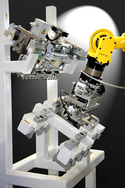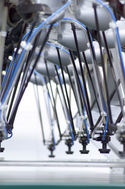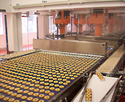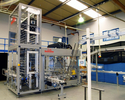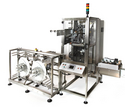The reality of robotics
7 October 2008Developments in robotic technology are increasing its suitability for packaging and handling applications, writes Mike Taylor
The fast-changing nature of the packaging industry requires production machinery that can be readily adapted to meet new requirements with the minimum of disruption to the production process. In addition to keeping pace with competitors, companies are under increasing pressure to meet tightening legislative and hygienic standards.
The specialist suppliers of modern robotic technology argue that its inherent adaptability makes it ideal for the rapid turnaround and production changes involved in packaging processes. Although robots are often seen as being inappropriate for food or pharmaceutical applications where hygienic wash-down is required, advances in technology mean packaging machinery users and manufacturers alike should take a second look at how to exploit their use.
Keeping clean
A good example of the possibilities for robotics meeting hygienic requirements comes from Sigpack Systems and CFS, who have co-operated to develop the RobotLoader, designed for use in the protein industry. Although automated processing and packaging machinery for this industry has existed for some time, the loading of products into packs has remained labour-intensive. Automated tray-loading has been difficult, due to high hygiene standards and irregular product shapes with slippery surfaces.
The system jointly developed by CFS and Sigpack automatically loads fresh meat, poultry, processed meat, cheese and sliced products into preformed trays or thermoformed packs. It has been designed to be “optimally hygienic and reliable, operating at very high speeds”. It is based on Sigpack’s Delta robot technology, which is said to employ sophisticated vision systems to guide the robots and has been used for a wide range of applications, including picking and placing of confectionery and biscuits, and top-loading in the pharmaceutical and cosmetics industries.
The Delta has also been in use in the chilled and frozen foods industry for some time. The frozen foods manufacturing environment presents several specific challenges for robots: the electronics had to be specially insulated within the machine and new types of grippers were developed. But, most importantly, the hygiene requirements are stringent: the robot cannot have any surfaces where detritus can collect, and must be easily washed with minimal downtime. The frames and drives are thus made from stainless steel.
The CFS RobotLoader has been designed to comply with ISO 14159 – European regulations, American Meat Industry (AMI) hygiene standards and US Food & Drug Administration criteria on materials for food contact. All components coming into contact with products can be “quickly changed” and “cleaned out of place”. The machine can be completely washed down “in half the time of comparable systems”, whilst the absence of a housing is said to make the robots easy to inspect and clean.
Combined with the CFS TwinStar for tray-sealing applications, the RobotLoader can comprise up to eight Delta robots in line, all controlled from one PLC. The vacuum system is in-line, facilitating easy installation and maintenance, and the line is said to be easily configured to fit existing factory layouts.
With thermoformed trays, the RobotLoader can be used for a range of fresh and frozen applications in-line with the CFS PowerPakNT thermoformer. Integration into the loading section of the thermoformer is said to allow perfect access for operation and cleaning of the complete system. Again, up to eight Delta robots can be used and film widths of 700mm accommodated.
ABB is another manufacturer offering a choice of “adaptable, cost-effective” robotic technology for hygienic packaging applications. The new second-generation FlexPicker IRB360 robot, for example, is “specifically and hygienically designed” for use in packaging applications with open food. It is also said to be faster, stronger and smaller than its predecessor, and can handle an increased range of objects, including large loads and fragile products previously unsuitable for robots.
For use in hygienic environments, the wash-down version features a special paint finish, corrosion-resistant material, sealed components and a fourth axis with slide bearings, facilitating easy cleaning with detergents. A stainless steel wash-down version is also available.
From the top
A robotic top-loading system for the packing of primary and secondary packs, suitable for use in the food, confectionery and personal care markets, has been launched by Sewtec Automation. The new LX5249 system can be tailored to individual product requirements and is said to offer speeds of up to 600 packs per minute (PPM), depending on the application.
A major innovation claimed is an optional integral storage system that will divert product away from the top-loader in the event of a downstream machine stoppage. Each product is individually handled and placed into storage from race-track compartments, eliminating any queuing or bunching and maintaining product quality, says Sewtec. The system is said to provide up to 10mins storage or longer (depending on the pack format) and packs can be automatically reintroduced into the line during normal production.
The robot features twin-axis servo-motion “for consistent and reliable operation”, controlled by either Allen Bradley or Siemens PLCs, enabling the equipment to be added to or expanded when required. A variety of robotic tooling is available to suit different products. This includes vacuum pick ‘n’ place, together with vacuum tooling with pneumatic repitching devices and pneumatic grippers.
Another new range of high-speed top-loaders is Paal’s Elematic 6000 F Series, which offer an interface said to add flexibility to their performance. An interesting option offered on all Elematic 6000 F-6 top loaders with six axes is a tool magazine for the different formats. For a size change, the robot is claimed to automatically "park" the current tool in the magazine, pick up the new tool, and then go back into full operation mode. “The fully-automatic tool change is completed within 20 secs. No tool has to be carried manually,” says the company.
On the case
At PackExpo, in Chicago, next month, Bradman Lake will debut the first of its new range of robotic case-packing machines. The robotic AX Case Packer is said to have a very compact footprint and eliminate the need for three separate machines. It will automatically form, top-load, fill and close RSC- and HSC-style corrugated cases within one frame.
Said to incorporate advanced design electronic motion control technology using a combination of robotics and servomotor drives, the AX will form the case, load the cartons/products and bottom/top-seal the case at a maximum output of 120 cartons/min and 12 cases/min, depending upon the shape and size of the products involved. Tape, glue, or a combination of both can be provided for case-sealing. Bradman Lake’s next innovation - the MX Case Packer - will be unveiled later this year. It is aimed at handling up to 240 cartons at a maximum rate of 20 cases/min.
Pallets packed
On the palletising front, Kuka has introduced a high-speed system that uses a standard robot, said to be capable of packing 25kg sacks at 24 units/min. The KR 180PA robot features a “lightweight, yet robust” carbon fibre arm and specially designed gripper for palletising a wide variety of bulk products, such as food processing ingredients, aggregates and chemicals.
Offering versatility, the 4-axis robot has a working envelope of 3.2m and is capable of stacking euro pallets up to 3m high. Kuka says it can operate for 20,000 working hours before requiring a service “which typically only takes around three hours”. The new palletiser could also be adapted at a later date by fitting a multiple gripper, facilitating the handling of even more bags. It is also said to be suitable for depalletising tasks involving mixed or unmixed pallets, cartonboard or plastic containers.
Robot sales specialist, Tony Dowling says Kuka has been “inundated with enquiries” from the food, chemicals and plastics sectors. “More companies are beginning to recognise the advantages of automation,” he affirms, “not only because of the benefits of better productivity, but also from a health and safety perspective, as robots can perform a variety of heavy and hazardous tasks.”
Partnership
Corrugated machine specialist, Smurfit Kappa Machine Systems, has joined forces with Fanuc Robotics (UK) as one of its Strategic Systems Partners. Fanuc will provide Smurfit with sales and engineering support to offer end-users “highly-efficient robot systems”. Smurfit has already supplied 10 Fanuc robot systems.
"We are continually identifying additional tasks that robots can undertake on our end-of-line systems," explains Matt Weeks, General Manager, Smurfit Kappa Machine Systems. “Keeping the robots fully utilised is our aim and we're excited by the prospect of future developments. The flexibility of the robots, together with their reliability, is a welcome benefit for this industry. Minimum time to market is critical in the Retail Ready Packaging business, and the flexibility and multi-tasking ability of robots is essential to the achievement of short lead times in a cost-effective manner.”
As a Strategic Partner to Fanuc Robotics, Smurfit's engineers have access to advanced programming training and support, together with the company's Roboguide bespoke simulation software to prove proposed systems. Programs generated by Roboguide are said to help reduce installation and commissioning time, together with increasing customer confidence by providing proof of achievable cycle times and capabilities.
In vision
For its new generation of automated packaging machines, Schubert has employed vision systems “specially designed to undertake a wider range of quality control checks”. In addition to its established vision technology for inspecting product height and position, the company has developed scanners that can verify the pattern, colour and surface decoration of products.
“This means our automated packaging machines can offer even higher levels of precision and flexibility," claims Alan Law, UK Managing Director. "Image data can be processed in milliseconds, ensuring that the system's robots can evaluate the quality of products precisely, based on a range of criteria such as position, orientation, shape, colour and texture."
The vibration-resistant incident light scanners provide a colour image of the product that is then communicated to the packaging line's pick-and-place robots, ensuring that only product of the correct quality is packed. The scanners have telecentric lenses and high-intensity LEDs that produce images with a resolution up to 0.125mm per pixel. They are also designed to handle belt conveyor speeds of more than 30m/min.
Schubert says its systems can inspect most products made by the food, beverage, healthcare, cosmetics and pharmaceutical industries. Typical applications include checking the amount of coating and decoration, identifying mis-shapen goods and sorting by label.
In one application, Burton's Foods has installed a Schubert automated packaging system for Jammie Dodgers biscuits at its Llantarnam bakery in Wales. The line boasts 16 robots that pick and place more than 1700 biscuits a minute in a round-the-clock operation, five days a week, according to the company. The robots pack eight Jammie Dodgers into each tray and can fill up to 220 trays a minute from the system's 1.6m conveyor, one of the widest ever built by Schubert.
The line also incorporates the new vision system, which checks the biscuits for surface decoration, pattern and colour. The incident light scanner takes a colour image of the product and communicates it to the system's robots so that only product of the correct quality is packed. Potential problems such as broken, displaced or missing shells are also identified.
"Jammie Dodgers were previously packed by hand and it was a monotonous, labour-intensive operation," says Ian Brisco, the factory’s general manager. “The Schubert system has exceeded all expectations.”
Plug-and-play
Elau claims its new Robot P3+ offers increased performance and application range as “a complete embedded delta 3 robotic system that will make it even easier to implement robotic packaging machines”. It provides three degrees of freedom for pick and place applications whilst, optionally, a fourth axis is possible by integrating a rotary axis at the tool centre point.
Equipped with intelligent servo modules instead of conventional servomotors and drives, the Robot P3+ is said to be easy to integrate into a packaging machine. Connected with a single quick-connect hybrid cable drop between servo modules and common power supply, it is claimed to be the first ‘plug-and-play’ robotic system. A single cabinet-mounted power supply can handle multiple robots in addition to the various servodrives in the packaging machine. Using I/O option modules, up to 24 distributed I/O points can be supported at each robot.
Elau offers customers “a rapid development path from concept to machine”, all within an IEC 61131-3 compliant software structure, running all kinematics, logic and motion in a single program on a single processor. “Optimised robotic motion profiles assure high machine cycle rates, whilst optimised tool centre-point programming assures gentle product handling at high speeds,” the company promises. “The robot now allows easy integration with the most popular vision systems that, like the robot itself, OEMs can readily embed into their programming as a configurable software module.”
The standard P3+ has a payload capacity of up to 2.5kg (double its predecessor), with diameters up to 1200mm now facilitating applications such as conveyor tracking on wide conveyor belts. Recent wiring innovations make it possible to bring cables up to the gripper with few loops, avoiding product contact. All enclosures are made of stainless steel and are said to be easy to clean.
Proved in practice
As packaging machine manufacturer Turpin’s Packaging Systems discovered, choosing the right supplier with the right ideas, technology and empathy can ease conversion to robotics and also be extremely beneficial. In a very short time, the Clacton-based manufacturer of Sleevit sleeve labelling equipment says it saw a machine performance increase of nearly 60 per cent.
The company had been approached by a US labelling equipment company requesting the supply of a sleeving machine for sale into the North American market. Turpin’s turned to Rockwell Automation, whose Integrated Architecture for automation and information facilitates realisation of the full range of automation disciplines, including sequential, motion, process/batch control, drive control and safety. Rockwell claims it reduces total cost to design, developing and delivering machines by using a single control platform for the entire range of factory automation applications, whether large or small.
Users with less complex applications can take advantage of Rockwell’s Compact Machine Solutions’ suite of integrated products, including the Allen Bradley CompactLogix controller family, PanelView Plus HMI terminals, POINT I/O modules, and PowerFlex 40 drives - all connected on a single industry-standard communication network, such as EtherNet/IP. Designed specifically for OEMs, this can reduce time to market, allow reuse of programming code and has built-in diagnostic and remote access capabilities – saving users both time and money, the company promises.
Kevin Wright, OEM Sales Manager, Rockwell, notes: "Often customers do not believe that a change in the control system can result in such a staggering increase in machine performance." This was the case with the use of the Compact Machine Solution at Turpin’s: so impressive were the increases that a project is now underway to redesign other elements of the machine to keep pace with the new performance.
He explains: "In this type of application, throughput is vital, and is often measured in hundreds of sleeves per minute. The previous system had been tuned over the last few years and was offering a maximum throughput of 300 cycles/min. Within 14 days of our hardware being installed, we had this figure up to 400, and within 30 days it was up to 475 cycles/min - an increase of nearly 60 per cent."
Chris Bates, Technical Director at Turpin’s, adds: "We began to realise that it was the electrical infrastructure of our machines that was preventing any further performance gains. Our existing solution was acceptable, but it was based on intelligent drives rather than a PAC and we really were at the absolute limit of its capabilities. The move over to Rockwell Automation's Integrated Architecture meant a significant shift for us. The huge throughput increase vindicated our thoughts that it was indeed the electrical infrastructure that was holding our machines back.”
He concludes: "The final, but arguably just as important, aspect of the relationship with Rockwell is the economic evaluation of the whole project. We are now where we want to be, with a product that is far outstripping its earlier performance, ready to take on an extremely demanding market."
On show
There will be an excellent opportunity to see the latest robotic packaging technology in action at first hand at Anuga FoodTec 2009, in Cologne on 10–13 March. One of the show’s highlights will be the ‘Robotik-Pack-Line’ - a robotic packaging line demonstrating “safe, quick and hygienic methods for producing, processing and packaging food products, all without human aid”.
First introduced at the event in 2006, the Robotik-Pack-Line technology has since been developed and implemented by a number of supplier partners. The results will be on display at Anuga FoodTec 2009 in the shape of a modular line that will produce, monitor, sort, package, weigh and then palletise complex, multi-component food products. “Particular emphasis in this process will be placed on the hygiene, monitoring, safety and regular cleaning of the conveyor belts. In addition, X-ray analysis will be used to ensure that contamination is detected and filtered out of the product,” says the company.
Future benefits
The suppliers and existing users believe that, as their benefits for packaging and handling operations become more apparent, robotic systems will be adopted increasingly in industries such as food and pharmaceuticals, where their hygienic design can improve product quality and safety, together with reducing labour and maintenance costs.
Sigpack’s Delta robot technology is said to employ sophisticated vision systems for robotic guidance The all-seeing robot The second-generation FlexPicker IRB360 robot from ABB is designed for easy washdown Clean, healthy robots Sewtec states that the new LX5249 system can be supplied with optional integral storage system that will divert product away from the top-loader in the event of a downstream machine stoppage. Reduced down-time It is claimed that the Paal Elematic 6000 F Series can undertake a fully-automatic tooling change within 20 secs Speedy tool changeover The Kuka KR 180PA robot features a carbon fibre arm and specially designed gripper for palletising a wide variety of bulk products, said to be capable of packing 25kg sacks at 24 units/min. Great gripper configuration The Schubert automated packaging system for Burton’s Foods comprises 16 robots, claimed to pick and place more than 1700 biscuits a minute Robots in unison Rockwell Automation’s Integrated Architecture for automation and information facilitates realisation of the full range of automation disciplines, including sequential, motion, process/batch control, drive control and safety Integrated architecture
